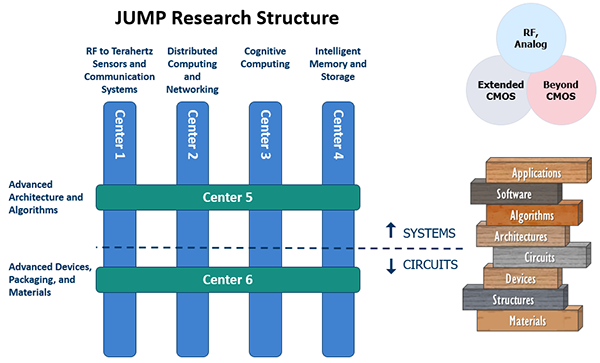JUMP Mission
The mission of JUMP is to look beyond today’s technology horizon and lay the scientific groundwork that extends the viability of Moore’s Law economics through 2040. This program must create new general purpose architectures and system designs that relax device constraints and provide opportunities for new device types and novel, heterogeneous integration solutions. It must invent new devices and designs that are capable of the performance achievable today at a power consumption that is 1-3 orders of magnitude lower. Finally, it must train tomorrow’s workforce to deliver “smart, autonomous, safe, connected, efficient, and affordable” electronics that meet our sensing, actuation, communication, computing, and storage needs for 2025 and beyond. In addition to providing enabling technologies, the research scope for each Center represents a critical component in the development of systems for both the semiconductor and defense industries and the Department of Defense.
Innovative ideas and fresh thought will be the catalyst to enable the technology roadmap for 2025 and beyond. There is no requirement to be from a participating SRC research university or to have been a previously sponsored SRC researcher. In fact, a key goal of this research announcement is to merge the ideas from established innovators within the existing university networks of SRC and the defense community with those from new, rising institutions or researchers.
The Joint University Microelectronics Program, or JUMP, supports long-term research focused on high performance, energy efficient microelectronics for end-to-end sensing and actuation, signal and information processing, communication, computing, and storage solutions that are cost-effective and secure. The highly-skilled students working on these research initiatives will ultimately become the workforce of tomorrow that will implement these technologies into commercial solutions.
Research commenced in January 2018 and will continue for five years, with funding support coming from industry and government partners. Total JUMP funding for the five-year period will be in excess of $150M, including funds committed by DARPA (Defense Advanced Research Projects Agency, www.darpa.mil), IBM Corporation, Northrop Grumman Corporation, Micron Technology, Inc., Intel Corporation, EMD Performance Materials (a Merck KGaA affiliate), Analog Devices Inc., Raytheon Company, Taiwan Semiconductor Manufacturing Company Ltd., Lockheed Martin Corporation, ARM Limited, Samsung Electronics Co., Ltd., and SK hynix Inc. Additional members are welcome.
Current planning supports six research themes across six JUMP centers and utilizes vertical and horizontal centers to capture the intersections of ideas. The focus research area of the individual centers and the overall organization is shown in the JUMP Research Structure graphic.
The vertical research centers emphasize application-oriented goals that focus on key issues facing the industry by addressing the full span of multi-disciplined science and engineering required to achieve breakthrough technologies and products. Proposers for each vertical center are expected to define a grand challenge in the research space that will be achieved by the center before the end of the JUMP program. Horizontal research centers will drive foundational developments in a specific discipline, or set of like-minded disciplines, will build expertise in and around key disciplinary building blocks, and create disruptive breakthroughs in areas of interest to JUMP members. Proposers from the horizontal centers are expected to define a set of key metrics that their center will use to benchmark and drive efforts in the defined research space.
Want to know more about how to participate as a member? Click here: JUMP Member Information



 SRC.org Links
SRC.org Links